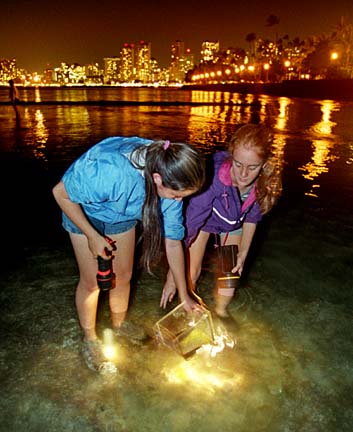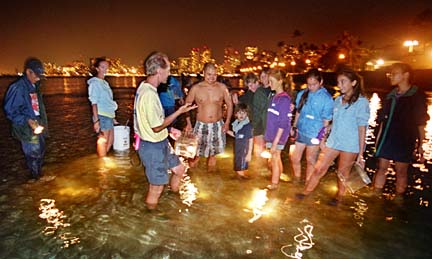


Simply splashing MOST PEOPLE don't care to know what lurks under the ocean after dark, but there are others who find the search for critters at night more entertaining than another night of staying home with reruns of "Friends."
Get your feet wet
By Nancy Arcayna
on a reef walk
Special to the Star-BulletinThe Waikiki Aquarium makes reef walking easy for novices with organized tours. Our adventure began as we headed out to the reef, flashlights in one hand and viewing boxes in the other. We strolled along the shallow reef, walking on old coral skeletons and seaweed. Sea cucumbers, swimming crabs, slipper lobsters, baby octopuses and ghost shrimp were among the creatures we managed to find. Everything was fine until a moray eel decided to peek out from under the reef. I stepped on a higher portion of the reef to avoid an encounter with him, but he decided to get friendly by slithering around my feet. Once the initial shock passed, the fellow was pretty interesting, and even I wanted to get a closer look.

"It's like going into a giant aquarium," said Mark Heckman, program director at the Waikiki Aquarium. "And you can learn most about sea animals by observing them in their own little universe. The night reef walks are popular, so we try to do them as often as we can."The tide needs to be very low, and shore and water conditions need to be accommodating. We find the most stuff in the shallowest areas," he explained.
You can do this on your own. Just get a tide chart and make sure the tide is at zero or a negative. And wherever the surf is bad, that is where you want to be. Wear waterproof shoes that cover your feet entirely. And, Heckman said, "be prepared to get wet to your knees or hips."
One of the main goals of the reef walking program is to teach people how to be "good reef visitors." A viewing box is used to scan the water surface to search for sea creatures.
"Nets are highly overrated," Heckman said. "People go into a hunting mode and automatically want to scoop something up. Some people take fish out of the water (causing them to gasp for air) or use the handle to poke holes to see if any animals are inside."

These measures may injure the sea creatures or disrupt their homes, he explains. Viewing boxes are available for purchase at fishing supply stores, or you can make your own from a plastic bucket or a flowerpot and a round piece of Plexiglas. The box allows people to scan the reef while maintaining personal safety and the safety of the reef animals.Moving in slow motion, we all searched for the creatures of the night. A slipper lobster leaped out and scared a group of girls who were collecting seaweed. Interest in creatures was often sparked by the shock factor.
"Nothing really scared me, but I was surprised at how soft and velvety the sea cucumber felt," Joy Sanada said.
"One sea cucumber looked like a hose to me, but it was sticky when you picked it up," added 11-year old Elizabeth Rian, who also enjoyed holding a baby octopus as it wrapped its tentacles around her finger.
Silvestre Lim was relieved that no dangerous creatures were lurking about on his journey to the reef. Some bottom-dwelling creatures have spines or other appendages that can puncture thin-soled shoes. The venomous sea urchins, cone snails, swimming crabs, scorpionfishes and moray eels all have defensive or feeding structures that can make them hazardous if handled.

Pauline Nguyen was chaperoning a group of young girls. "This is our third time. It's just amazing what is out at night. Plus it's a lot of fun to try to stay out of the holes," she said."The shrimp was really cool 'cause he had beady eyes, so we followed him around," said 12-year-old Alycia Bakke.
"The guy (Heckman) said that it was hard to catch them, but we just scooped him up," Sabrina Blanco said.
Another 12-year-old, Aileen Maldonado, also enjoyed observing the shrimp.
"I like the shrimp with the glowing eyes. You can see all the eyes looking at you when you shine a flashlight into the holes," she said.
"The holes in the reef surprised me, but seeing the sea animals was pretty cool," said 9-year-old Kim Adams.
"I thought the holes and trough were scary because it seemed like we could fall into this big space we didn't know about," added 11-year-old Tess Satsuma.
Heckman cautions individuals to stay within their comfort zone. Watch where you step and be suspicious of anything that doesn't have seaweed growing on it, he says.
Most importantly, the slower you move, the more creatures you will see.
Every time your foot hits the bottom, things shift and disappear.
Another reason for moving slowly is safety. Spines can go into fingers and cause itching, tingling or other reactions. And you don't want to fall on your hands and face. "You'll look ugly and then no one will want to talk to you," Heckman said.
What: "Exploring the Reef at Night" After dark
Place: Waikiki Aquarium
Call: 923-9741
Cost: $10; $8 children
Also: "Exploring the Reef by Day" tours take place from 8 to 10:30 a.m. April 22 and May 5, and 7:30 to10 a.m. May 20 and June 3
1. Determine the size of the viewing box. One-gallon buckets are better for children. Adults may prefer a 2- to 5-gallon bucket. Plastic flower pots or other tall-sided containers also make good viewing boxes. Building a reef walk
viewing box2. Cut out the bottom of the bucket with a coping or a thin blade saw. Leave a 1/2- to 1-inch lip.
3. Lay a bead of clear silicone caulk on the inside of the lip.
4. Insert a piece of clear Plexiglas or plastic and press down to seal. Min Plastics or Hawaii Plastics will cut plastic to required dimensions.
Plastic can also be purchased at some hardware stores.
5. Allow the caulk to dry for 24 hours.
6. Check for leaks by filling the bucket. If it leaks, you can either start over or add a bead of caulk to the inner and outer edges of the Plexiglas.
Click for online
calendars and events.